Tougher than Everesting: I rode up Box Hill 91 times
To highlight the shocking statistics on men’s mental health, Chris Hall rode down, and up, Box Hill 91 times. He tells Vern Pitt how it went

(Andrew Richardson)
It’s the early hours of Sunday morning on the slopes of the famous Box Hill in Surrey. The mercury has dropped below zero and the surface is starting to get slippery. Bombing down through the darkness for the umpteenth time, his way lit only by the lights on his bike, ultra-endurance athlete Chris Hall tentatively squeezes the brakes through the Olympic climb’s off-camber hairpin.
He’s lost track of the number of times he’s done this now, his body and brain chilled to the bone and his head is starting to loll with fatigue, his eyelids getting heavy. An icy slip could derail his whole quest to complete his metaphorical, and literal, descent into the darkness. Things are getting dangerous.
Hall’s mission that night was the same as it had been for the previous 24 hours – to descend, in distance, to the deepest point on earth, a place where little life survives, the Mariana Trench. The idea was to raise money for charity Movember and raise awareness of men’s mental health issues, depression in particular.
Why the Mariana Trench? “It relates to that idea of spiraling down and that spiraling out of control. But also, there’s a way out of it, you can climb out, and you can get out of that situation as well.”
But why do it on Box Hill, one of the busiest climbs in the country? “We were talking about the 2018 suicide statistics, and it really quite shocked me. Any suicide is a tragedy, the person could have been saved, or it could have been prevented. But what shocked me is three-quarters of all suicides in the UK are men. That’s 13 every day, 91 a week, or one every two hours,” says Hall.
So struck was he that he wanted to highlight that number, partly because he fears, as many experts in the field do, that the rigours of 2020 will make numbers like that a lot worse.
Box Hill was only the third location he tried crunching the numbers on and miraculously it worked. Hall then created a segment that was slightly longer than the usual one to give himself a margin for error. But going downhill is no challenge at all right? Unfortunately, that does mean you have to ride back up again – 91 times. All 11,034m of ascent.
Get The Leadout Newsletter
The latest race content, interviews, features, reviews and expert buying guides, direct to your inbox!

Hall, a trained architect and graphic designer by trade, is no stranger to ultra-endurance events, time trials and challenges. He’s raced multi-day ultra-endurance races in the mountains, clocked up a top 10 finish at the 24-hour time trial National Championship in 2017 and that same year set out to do 107km a day for 107 days in aid of the Pace Centre, a school for kids with motor disorders such as cerebral palsy (there are 107 pupils at the school).
Given all that, did Hall have any second thoughts? “I’ve done a lot of crazy things on bikes but this was probably the one I was probably the most nervous for. And I think the reason was because I didn’t really know how I was going to go.
“I knew it was going to be a lot of kilometres, and it was going to be a lot of climbing. I put it out there on social media. I did that on purpose to basically go, ‘I’m doing this.’”
Hall had not long returned from riding around the country, doing 107 miles a day (in aid of the Pace Centre again) to cover the length and breadth of the UK. So he had banked some good fitness from that and the month he took off afterwards, but even so, with just a month to prepare, “it was going to be tight”.
Dawn rider

So at 6am in the dark on Saturday, 28 November he set off on his Cervélo Aspero (he is sponsored by the Canadian brand) fitted with an 11-40 cassette and 46-39 chainrings. “It wasn’t as cold as I thought it was going to be and that was a pleasant surprise,” Hall recalls. “It did start raining at about half six.
I was instantly caked in mud. I was wearing these long overshoes, they were coated and the bike was covered.’”
Hall says the key to completing it was breaking down the challenge into four-hour chunks, as he would do with a 24-hour time trial.
“Generally you can carry enough water for four hours on your bike. And enough food without having disgustingly over-the-top pockets,” he explains. He advocates citrus as a palate cleanser for endurance events to break up the onslaught of sweet stuff. Hall ate tomato and cheese pasta during stops, to give him something savoury to chew on. “These things tend to turn into an eating contest,” he says.
As is often the case the initial stints were fairly drama-free, maintaining a steady power output under 250W in his zone two. During daylight hours he was spotted by many riders who offered encouragement and his friend, YouTuber Francis Cade, also came to ride with him for a while. He hadn’t been able to publicise the ride too much as Covid-19 regulations at that time stipulated you were only allowed to ride with one other person.
As fatigue set in, errors started to creep in. “I was climbing, descending and hitting the lap button on my computer, climbing, descending, lapping. It sounds easy. But when you’re really tired, it’s hard to focus on.

“I definitely forgot to lap it a few times. I think I probably ended up doing two or three more reps than I probably needed to,” he says, laughing at it now.
As he approached the 24-hour mark in the early hours of the morning was when it started to get really tough. “In 24-hour TTs I’ve always found those hours hard. And it’s just because your body cycle wants you to be asleep. Everything is telling you, you need to be in bed.
“I found it particularly hard this time. I was struggling to hold decent power numbers but the bit that I didn’t expect was my whole body was so trashed, it was just trying to shut down. You know when your head starts to nod when you’re really tired? I was doing that,” he recalls.
Hall continues: “I stopped at, I think it was, four o’clock for a reload of water and food. And I couldn’t warm up. I couldn’t stop shivering.”
His partner wrapped her long puffer jacket “like a football manager’s” around Hall and yet he was still struggling to get warm. He was set on continuing but decided he badly needed a power-nap.
“I’m incredibly proud that I was mature enough to make that decision. In the past I would have gone with it and potentially something quite bad may have happened,” he says, pointing out it wasn’t a race, it was about completing the ride. This has strong parallels with the cause Hall was riding for, as soldiering on can frequently seem like the best solution to mental health issues, when giving yourself a break is what is needed.
After a 30-minute nap and a chance to warm up, Hall set off on the final push, knowing the approaching dawn would lift his spirits. There was no big celebration at the finish line, no ticker tape, just a damp man in a car park bundled into the passenger seat by his partner before he set off home – via a pizza.
Humbling experience

Later he got to grips with the reaction to his ride. “I’ve been humbled by the support and people sharing why they’ve donated and their reasoning for donating has been really, really humbling,” he says.
“Quite a lot of people who’ve opened up about their own mental health to me, and who’ve also told me that, realising how alarming the statistics are, they’ve reached out to someone that they’ve not maybe heard from in a while. And they have been very glad that they have.
“It’s done what I wanted to do more than anything, which was to start a discussion and to cause a talking point,” Hall says.
Would he return to Box Hill to do it again? “I’ve got no intention of going back to that hill any time soon. I’ve done enough stints on that hill to really stave off any interest in going there for a lifetime,” says the heroic Hall with understandable feeling.
You can still donate to Chris Hall’s Movember fundraising page here.
This feature originally appeared in the print edition of Cycling Weekly, on sale in newsagents and supermarkets, priced £3.25.

Thank you for reading 20 articles this month* Join now for unlimited access
Enjoy your first month for just £1 / $1 / €1
*Read 5 free articles per month without a subscription

Join now for unlimited access
Try first month for just £1 / $1 / €1
Having trained as a journalist at Cardiff University I spent eight years working as a business journalist covering everything from social care, to construction to the legal profession and riding my bike at the weekends and evenings. When a friend told me Cycling Weekly was looking for a news editor, I didn't give myself much chance of landing the role, but I did and joined the publication in 2016. Since then I've covered Tours de France, World Championships, hour records, spring classics and races in the Middle East. On top of that, since becoming features editor in 2017 I've also been lucky enough to get myself sent to ride my bike for magazine pieces in Portugal and across the UK. They've all been fun but I have an enduring passion for covering the national track championships. It might not be the most glamorous but it's got a real community feeling to it.
-
 'It took everything' - Puck Pieterse outclimbs Demi Vollering to win La Flèche Wallonne
'It took everything' - Puck Pieterse outclimbs Demi Vollering to win La Flèche WallonneDutch 22-year-old shows Classics pedigree with first one-day victory
By Tom Davidson
-
 Tadej Pogačar flies to dominant victory at La Flèche Wallonne
Tadej Pogačar flies to dominant victory at La Flèche WallonneSlovenian takes second win at Belgian classic ahead of Kévin Vauquelin and Tom Pidcock
By Tom Thewlis